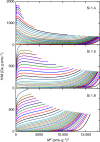A quantitative criterion for determining the order of magnetic phase transitions using the magnetocaloric effect
- PMID: 29992958
- PMCID: PMC6041331
- DOI: 10.1038/s41467-018-05111-w
A quantitative criterion for determining the order of magnetic phase transitions using the magnetocaloric effect
Abstract
The ideal magnetocaloric material would lay at the borderline of a first-order and a second-order phase transition. Hence, it is crucial to unambiguously determine the order of phase transitions for both applied magnetocaloric research as well as the characterization of other phase change materials. Although Ehrenfest provided a conceptually simple definition of the order of a phase transition, the known techniques for its determination based on magnetic measurements either provide erroneous results for specific cases or require extensive data analysis that depends on subjective appreciations of qualitative features of the data. Here we report a quantitative fingerprint of first-order thermomagnetic phase transitions: the exponent n from field dependence of magnetic entropy change presents a maximum of n > 2 only for first-order thermomagnetic phase transitions. This model-independent parameter allows evaluating the order of phase transition without any subjective interpretations, as we show for different types of materials and for the Bean-Rodbell model.
Conflict of interest statement
The authors declare no competing interests.
Figures










References
-
- Bratko M, et al. Determining the first-order character ofLa(Fe,Mn,Si)13. Phys. Rev. B. 2017;95:064411. doi: 10.1103/PhysRevB.95.064411. - DOI
-
- Morrison K, Moore JD, Sandeman KG, Caplin AD, Cohen LF. Capturing first- and second-order behavior in magnetocaloric CoMnSi0.92Ge0.08. Phys. Rev. B. 2009;79:134408. doi: 10.1103/PhysRevB.79.134408. - DOI
-
- Herrero-Albillos J, et al. Nature and entropy content of the ordering transitions in RCo2. Phys. Rev. B. 2006;73:134410. doi: 10.1103/PhysRevB.73.134410. - DOI
-
- Franco V, et al. Predicting the tricritical point composition of a series of LaFeSi magnetocaloric alloys via universal scaling. J. Phys. D. Appl. Phys. 2017;50:414004. doi: 10.1088/1361-6463/aa8792. - DOI
Publication types
LinkOut - more resources
Full Text Sources
Other Literature Sources

